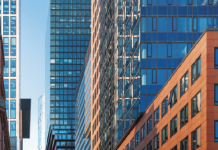
Green building in Canada has reached a significant milestone, with the Canada Green Building Council (CaGBC) reporting that there are now more than one billion square feet of LEED projects in Canada.
Representing nearly 7,000 LEED buildings, homes and communities since 2004, this growth can be attributed to the successful and widespread adoption of LEED by Canada’s industry, leading to significant innovation and economic development, CaGBC says in a statement.
As the federal government plans for the implementation of the Pan-Canadian Framework on Clean Growth and Climate Change – which recognizes the building sector as an area critical to the reduction of emissions – the building industry’s widespread LEED experience will be crucial to its success.
“We have just 13 years to reach aggressive national and international commitments to climate change,” says CaGBC president and CEO Thomas Mueller. “Our members, stakeholders and the green building industry have proven that we are ready to take on this challenge. With over one billion sq. ft. of LEED projects across the country, a new more rigorous version of LEED, and the release of a net zero carbon standard for Canada coming mid-year – it is evident that we are ready to hit the ground running and do our part in the countdown to 2030.”
As the world moves toward a low carbon economy, CaGBC is pushing higher standards for the performance of buildings (both new and existing) through LEED v4. It is also moving ahead with plans to support the industry by providing Canada’s first state-of-the-art guideline and third-party verification for zero carbon buildings, the CaGBC statement says. In addition, the organization says it is expanding research and consultations on existing buildings to determine how Canada’s infrastructure can be better managed and retrofitted – both to stimulate job growth and reduce GHG emissions.
In a preview of what is to come, LEED’s end of year totals for 2016 were strong overall, with a total of 406 LEED projects certified between Jan. 1 and Dec. 31, 2016. This brings the grand total of certified projects in Canada to 2,990.
Final totals by LEED certification level for 2016 were:
- 70 LEED Certified
- 154 LEED Silver
- 152 LEED Gold
- 30 LEED Platinum
The top five *provinces for LEED certification across Canada in 2016 were:
- Ontario – 147
- Quebec – 103
- British Columbia – 62
- Alberta – 61
- Manitoba – 10
*Note: these are totals for the year, not cumulative.
In addition to hitting one billion sq. ft. in LEED registered space, other notable progress in 2016 included:
- 270 Albert St. in Ottawa became the first commercial project in Canada to earn a LEED v4 Gold certification in the Existing Buildings category in November 2016. Managed by Blackwood Partners, the team on this project was able to improve the building’s energy performance by 25 per cent using LEED, resulting in (among other things) an ENERGY STAR score that placed the building in the 91st percentile amongst its peers.
- In the first quarter of 2016, Canadian LEED certified projects reached a cumulative reduction of over one million tonnes of CO2e in greenhouse gas emissions – the equivalent of taking 238,377 cars off the road for a year.
- LEED Gold certified projects also surpassed 1,000 in the first quarter of 2016. LEED Gold makes up 42 per cent of all LEED certified projects in Canada – the highest percentage of all levels.
- The TD Bank Group office in Toronto earned the first WELL v1™ certification in the world, with its renovation of 25,000 sq. ft. of corporate office space.
- Canada was named as a top country for LEED projects internationally by the USGBC for the third year in a row.
- CaGBC named the Career and Technology Centre at Lord Shaughnessy High School in Calgary as the Greenest School in Canada for 2016, for its environmental curriculum and programs that encourage students to think more innovatively.
The rise of green building and its influence on climate policy in Canada is also detailed in an update to the LEED in Motion: Canada report from the U.S. Green Building Council, published in mid January, which includes key highlights on CaGBC’s progress in advocating for green buildings in 2016.
For ongoing updates on LEED in Canada, visit www.cagbc.org/LEED.




